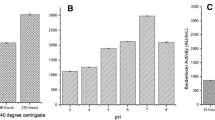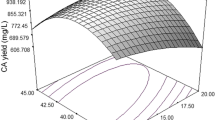Abstract
Artificial neural network (ANN) and genetic algorithm (GA) were applied to optimize the medium components for the production of actinomycinV from a newly isolated strain of Streptomyces triostinicus which is not reported to produce this class of antibiotics. Experiments were conducted using the central composite design (CCD), and the data generated was used to build an artificial neural network model. The concentrations of five medium components (MgSO4, NaCl, glucose, soybean meal and CaCO3) served as inputs to the neural network model, and the antibiotic yield served as outputs of the model. Using the genetic algorithm, the input space of the neural network model was optimized to find out the optimum values for maximum antibiotic yield. Maximum antibiotic yield of 452.0 mg l−1 was obtained at the GA-optimized concentrations of medium components (MgSO4 3.657; NaCl 1.9012; glucose 8.836; soybean meal 20.1976 and CaCO3 13.0842 gl−1). The antibiotic yield obtained by the ANN/GA was 36.7% higher than the yield obtained with the response surface methodology (RSM).





Similar content being viewed by others
References
Baishan F, Hongwen C, Xiaolan X, Wan Ning A, Zongding H (2003) Using genetic algorithms coupling neural networks in a study of xylitol production: medium optimisation. Pro Biochem 38:979–985
Baughman DR, Liu YA (1995) Neural Networks in Bioprocessing and Chemical Engineering. Academic, San Diego
Bird CW, Latif M (1981) Antibiotics from a newly isolated S. elizabethii II Isolation and characterization of antibiotics. J Chem Technol Biotechnol 31:368–370
Box GEP, Hunter WG, Hunter JS (1978) Statistics for experiments. Wiley, New York, pp 291–334
Castro PML, Hayter PM, Ison AP, Bull AT (1992) Application of a statistical design to the optimization of culture medium for recombinant interferon-gamma production by Chinese hamster ovary cells. Appl Microbiol Biotechnol 38:84–90
Cheema JJS, Sankpal NV, Tambe SS, Kulkarni BD (2002) Genetic programming assisted stochastic optimization strategies for optimization of glucose to gluconic acid fermentation. Biotechnol Prog 18:1356–1365
Chhatpar HS, Vaidya R, Vayas P (2003) Statistical optimization of medium components for the production of chitinase by Alcaligenes xylosoxydans. J Enz Microb Technol 33:92–96
El Naggar Moustafa YM, El Aassar Samy A, Hashem MA, Stoodley RJ, Raynor CM, Sigee DC (1998) Production of actinomycin X2 by immobilized S. nasri YG62 mycelia. Microbios 95:165–179
Fannin TE, Marcus MD, Anderson DA, Bergman HL (1981) Use of a fractional factorial design to evaluate interactions of environmental factors affecting biodegradation rates. Appl Environ Microbiol 42:936–943
Foster JW, Katz E (1981) Control of actinomycin D biosynthesis in Streptomyces parvulus: regulation of tryptophan oxygenase activity. J Bacteriol 148:670–677
Franco-Lara E, Hannes L, Dirk WB (2006) Evaluation of artificial neural networks for modelling and optimization of medium composition with a genetic algorithm. Process Biochem 41:2200–2206
Furuhashi K, Takagi M (1984) Optimization of a medium for the production of 1,2-epoxytetradecane by Nocardia corallina B-276. Appl Microbiol Biotechnol 20:6–9
Gallo M, Katz E (1972) Regulation of secondary metabolite biosynthesis catabolite repression of phenoxazone synthase and actinomycin formation by glucose. J Bacteriol 109:659–667
Goldberg D (1989) Genetic algorithms in search, optimization, and machine learning. Addison-Wesley, Reading
Ha SC, Hong SD (1994) Identification of actinomycete strain No. 1372 a producer of actinomycin X2. Sanop Misaengmul Hakhoechi 22:164–168
Haider MA, Pakshirajan K, Singh A, Chaudhry S (2008) Artificial neural network-genetic algorithm approach to optimize media constituents for enhancing lipase production by a soil microorganism. Appl Biochem Biotechnol 144:225–235
Houck CR, Joines JA, Kay MG (1995) A genetic algorithm for function optimization: a matlab implementation. Technical Report NCSU-IE TR 95-09. North Carolina State University, Raleigh, NC
Kurosawa K, Bui VP, VanEssendelft JL, Willis LB, Lessard PA, Ghiviriga I, Sambandan TG, Rha CK, Sinskey AJ (2006) Characterization of Streptomyces MITKK-103, a newly isolated actinomycin X2 producer. Appl Microbiol Biotechnol 72:145–154
Lackner H, Bahner I, Shigematsu N, Panell LK, Magner AB (2000) Structures of five components of actinomycin Z complex from S. fradiae, two of which contain 4-chloro threonine. J Nat Prod 63:352–356
Morioka H, Taicezawa M, Shibai H (1985) Actinomycin V as a potent differentiation inducer of F5-5 Friend leukemia cells. Agri Biol Chem 49:2835–2842
Nagata Y, Chu KH (2003) Optimization of a fermentation medium using neural networks and genetic algorithms. Biotechnol Lett 25:1837–1842
Pundle AV, Raman HS (1994) Medium optimization for the production of penicillin V acylase from Bacillus sphaericus. Biotech Lett 16:1041–1046
Rao CS, Sathish T, Mahalaxmi M, Laxmi GS, Rao RS, Prakasham RS (2007) Modelling and optimization of fermentation factors for enhancement of alkaline protease production by isolated Bacillus circulans using feed-forward neural network and genetic algorithm. J Appl Microbiol 104:889–898
Silveira RG, Kakizono T, Takemoto S, Nishio N, Nagai S (1991) Medium optimization by an orthogonal design for the growth of Methanosarcina barkeri. J Ferm Bioeng 72:20–25
Thiel T, Bramble J, Rogers S (1989) Optimum conditions for growth of cyanobacteria on solid media. FEMS Microbiol Lett 61:27–31
Williams WK, Katz E (1977) Development of a chemically defined medium for the synthesis of actinomycin D by Streptomyces parvulus. Antimicrob Agents Chemother 11:281–290
Windsor SA, Tinker MH (1996) Binding of biologically important molecules to DNA, probed using electro-fluorescence polarization spectroscopy. Biophys Chem 58:141–150
Acknowledgment
The authors would like to thank the Council of Scientific and Industrial Research (CSIR), India for financial support.
Author information
Authors and Affiliations
Corresponding author
Rights and permissions
About this article
Cite this article
Singh, V., Khan, M., Khan, S. et al. Optimization of actinomycin V production by Streptomyces triostinicus using artificial neural network and genetic algorithm. Appl Microbiol Biotechnol 82, 379–385 (2009). https://doi.org/10.1007/s00253-008-1828-0
Received:
Revised:
Accepted:
Published:
Issue Date:
DOI: https://doi.org/10.1007/s00253-008-1828-0




